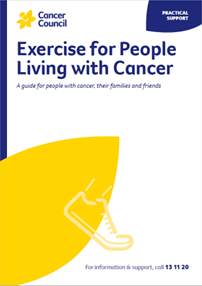- Home
- About Cancer
- Living well
- Exercise for people living with cancer (with videos)
- Aerobic and cardio
Aerobic and cardio exercise
Aerobic exercise uses large muscle groups repetitively over an extended period of time and causes your heart and breathing rates to rise during the activity. This is sometimes called cardiovascular (cardio) exercise. This type of exercise may improve side effects, mood and energy levels.
How much exercise should I do?
Exercise at a level you are comfortable with, but try to vary how long (duration) and how hard (intensity) you exercise. You can start with a small amount and increase it gradually as you feel able. Find out about current recommendations for aerobic and cardio exercise.
What is exercise intensity?
How hard your body is working during physical activity, particularly aerobic exercise, is known as exercise intensity. It’s usually described as low, moderate or vigorous. A simple way to work out the intensity of aerobic and cardio exercise is the talk test.
| Low intensity exercise | You can talk or sing at the same time. An example is gentle walking, light gardening or slow cycling. |
| Moderate intensity exercise | Your heart will beat faster, you’ll breathe harder than normal and you may start sweating. You’ll be able to speak but only in short sentences or have a slower than normal conversation. Examples include brisk or fast walking, water aerobics, dancing, tennis (doubles), cycling and swimming. |
| Vigorous intensity exercise | You’ll be sweating, puffing and your heart will be beating rapidly. You won’t be able to talk without pausing. Examples include aerobic/cardio classes, jogging, tennis (singles), and organised sports such as football, soccer or netball. |
→ READ MORE: Strength and resistance training
Video: Exercise and cancer
Podcast: Meditation and Relaxation
Listen to more of our meditation and relaxation podcast for people affected by cancer
More resources
Kirsten Adlard, Accredited Exercise Physiologist, The University of Queensland, QLD; Dr Diana Adams, Medical Oncologist, Macarthur Cancer Therapy Centre, NSW; Grace Butson, Senior Physiotherapist, Peter MacCallum Cancer Centre, VIC; Kate Cox, 13 11 20 Consultant, Cancer Council SA; Wai Yin Chung, Consumer; Thomas Harris, Men’s Health Physiotherapist, QLD; Clare Hughes, Chair of Cancer Council’s Nutrition, Alcohol and Physical Activity Committee; Jen McKenzie, Level 1 Lymphoedema Physiotherapist, ESSA Accredited Exercise Physiologist, The McKenzie Clinic, QLD; Claudia Marck, Consumer; Dr David Mizrahi, Accredited Exercise Physiologist and Research Fellow, The Daffodil Centre at Cancer Council NSW and The University of Sydney, NSW; Prof Rob Newton, Professor of Exercise Medicine, Exercise Medicine Research Institute, Edith Cowan University, WA; Jason Sonneman, Consumer.
View the Cancer Council NSW editorial policy.
View all publications or call 13 11 20 for free printed copies.

